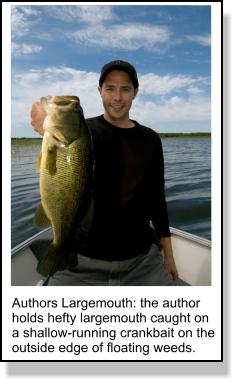

Editors & Publishers
T.J. & Monique Quesnel
The
Ontario Fishing Network
E-Magazine is
published 12 times a year on or near the beginning of every month. Our
magazine is geared to any angler who enjoys fishing of any type in the
wonderfully diverse province of Ontario.
Editorial Submissions: We welcome query letters,
but assume no responsibility for unsolicited materials.
Subscriptions: Subscriptions are FREE of charge
and delivered via email.
You can subscribe
HERE:
Privacy Policy: Unlike other publications We
NEVER make our subscribers list (your email address) available to any
other companies.
Advertising: If you are interested in advertising
please email us.
Circulation - 9,500 email subscribers
© 2009 Due North
Marketing / Ontario Fishing Network / T.J. Quesnel. All rights
reserved. Reproduction of any material without prior written
permission strictly prohibited.
|
 Shallow-Running
Cranks for Weed-Relating Largemouth Shallow-Running
Cranks for Weed-Relating Largemouth
By Tim Allard
Weeds are one of the most important types of cover in largemouth
bass fishing. Many anglers have become conditioned to toss
Texas-rigged plastics, flipping jigs, topwater frogs and
spinnerbaits around weeds because theyíll not foul easily on stalks
and leaves. These lures will work well, but sometimes
shallow-running crankbaits deliver better catches around weeds. If
youíre not tossing crankbaits around weeds, youíre missing out on a
big-fish producer.
Hereís what you need to know about this
presentation in shallow water scenarios.
Why Fish the Weeds with Cranks
Iíll be the first to admit youíll get hung up when working
crankbaits in weeds. The odd hang up is worth it though because
crankbaits deliver a presentation that weedless baits canít deliver.
Their wobbling creates turbulence in the water and internal rattles
really appeal to largemouth on certain days. Add to these traits the
reality that many anglers are reluctant to toss baits around weed
areas, so with a crank youíre likely offering bass a bait they
havenít seen in a while, at least in weedy cover anyway.
Although occasional snag is the nature of this presentation, you can
often minimize foul-ups by choosing the right baits for the weed
area youíre fishing. For this reason, I like floating,
shallow-running crankbaits in skinny water, weed areas.
 Shallow Runners Shallow Runners
Shallow-running crankbaits are extremely effective for fishing weed
areas. Some baits literally skim only inches below the surface while
others dive to a few feet. Which style of bait you opt for depends
on the weed conditions youíre fishing. Examples of these lures
include Mannís 1-Minus series, Bagleyís Wakeín B, or Rapalaís DT Fat
Series.
In most shallow, weed conditions, I like to use a floating crankbait
designed to stay in the top foot of the water column, but often keep
the bait bulging just beneath the surface on slow retrieves. This
mimics an easy and vulnerable target for bass in the area. These
particular cranks afford me plenty of advantages in the skinny
water.
Top Casting Spots
As the bait has a shallow running depth it remains visible during
the retrieve. This lets me watch the lure and steer it around
obstacles and through floating weed areas. Iíll guide the crank
through sparsely grown lily pads or along the edge of surface
plants, like reeds or arrow heads. Staying close to the surface also
makes the bait perfect for running over weed tops without digging
into the vegetation. If I bump a log or rock, I stop the retrieve
and often the floating crank will back up and out of the
obstruction. As baits float Iíll often pitch them into large
pockets. If thereís a bass around I usually only get in a few turns
of the reel handle before a bucketmouth crushes the crankbait.
 The Right Weed Stick The Right Weed Stick
When casting shallow-running crankbaits around weeds, the workhorse
of my line up is a heavy-power, fast-action casting rod. This stick
easily handles the heavy, plastic crankbaits I like to use. Its
power also easily pulls big fish quickly from heavy cover, ensuring
I donít give bass an inch of string to tangle my line in the
underwater obstacles.
As Iím often using this pole for shallow water presentations, I
spool it up with 17-pound test, abrasion-resistant monofilament.
Monoís floating characteristics keeps the lure running high in the
water column. Also, because Iím using such a stiff stick, I like
that mono offers a bit of stretch to help bass engulf the offering.
If you choose mono, regularly inspect your line for wear and tear
when working cover and retie at the slightest sign of weakness.
Weeds are one of the most important types of cover in largemouth
bass fishing. It might seem counter-intuitive to toss a multi-treble
hook bait in a snag-laden area, but cranks can cough up big bass out
of weeds when other lures donít produce. Yes, casting these baits
requires patience as occasional foul ups are part of the game, but
the efforts worth it when you lip a sow from the green caught on a
crank.
|